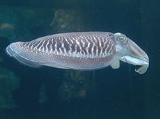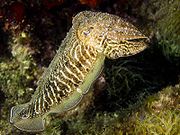
Common Cuttlefish
Encyclopedia
The Common Cuttlefish or European Common Cuttlefish (Sepia officinalis) is one of the largest and best known cuttlefish
species. It grows to 49 cm in mantle
length (ML) and 4 kg in weight. Animals from subtropical seas are smaller and rarely exceed 30 cm in ML.
The Common Cuttlefish is native to at least the Mediterranean Sea
, North Sea
, and Baltic Sea
, although subspecies have been proposed as far south as South Africa
. It lives on sand and mud seabeds to a depth of around 200 m. As in most cuttlefish species, spawning
occurs in shallow waters.
 Known predators of S. officinalis include large fish
Known predators of S. officinalis include large fish
(such as monkfish
and swordfish
, Xiphias gladius) and whales.
In the wild, S. officinalis is known to prey upon a wide variety of animals. These include: bony fishes, copepod
s, crustacean
s (including Astacus leptodactylus
, Carcinus
sp., Crangon sp., Daphnia
sp., Gammarus
sp., Mugil
sp., Mysis
sp., Penaeus
sp., Praunus sp., Sphaeroma sp., Squilla
sp.), decapod cephalopods
, gastropods, lamellibranches, nemerteans, octopods
, ostracod
s, polychaete
s, and pteropods.
A 2008 study on S. officinalis revealed that cuttlefish embryos, if visually exposed to a certain species of prey (e.g. crab
s), will hunt primarily for that prey in later life. S. officinalis usually prefer shrimp to crabs, but when the embryos were exposed to crabs and the embryos had hatched, the young cuttlefish switched preferences and proceeded to hunt the crabs more often than the shrimp.
.
Sepia officinalis jurujubai Oliveira, 1940, originally described as a subspecies
of the Common Cuttlefish, is a junior synonym of Sepioteuthis sepioidea.
Cuttlefish
Cuttlefish are marine animals of the order Sepiida. They belong to the class Cephalopoda . Despite their name, cuttlefish are not fish but molluscs....
species. It grows to 49 cm in mantle
Mantle (mollusc)
The mantle is a significant part of the anatomy of molluscs: it is the dorsal body wall which covers the visceral mass and usually protrudes in the form of flaps well beyond the visceral mass itself.In many, but by no means all, species of molluscs, the epidermis of the mantle secretes...
length (ML) and 4 kg in weight. Animals from subtropical seas are smaller and rarely exceed 30 cm in ML.
The Common Cuttlefish is native to at least the Mediterranean Sea
Mediterranean Sea
The Mediterranean Sea is a sea connected to the Atlantic Ocean surrounded by the Mediterranean region and almost completely enclosed by land: on the north by Anatolia and Europe, on the south by North Africa, and on the east by the Levant...
, North Sea
North Sea
In the southwest, beyond the Straits of Dover, the North Sea becomes the English Channel connecting to the Atlantic Ocean. In the east, it connects to the Baltic Sea via the Skagerrak and Kattegat, narrow straits that separate Denmark from Norway and Sweden respectively...
, and Baltic Sea
Baltic Sea
The Baltic Sea is a brackish mediterranean sea located in Northern Europe, from 53°N to 66°N latitude and from 20°E to 26°E longitude. It is bounded by the Scandinavian Peninsula, the mainland of Europe, and the Danish islands. It drains into the Kattegat by way of the Øresund, the Great Belt and...
, although subspecies have been proposed as far south as South Africa
South Africa
The Republic of South Africa is a country in southern Africa. Located at the southern tip of Africa, it is divided into nine provinces, with of coastline on the Atlantic and Indian oceans...
. It lives on sand and mud seabeds to a depth of around 200 m. As in most cuttlefish species, spawning
Spawn (biology)
Spawn refers to the eggs and sperm released or deposited, usually into water, by aquatic animals. As a verb, spawn refers to the process of releasing the eggs and sperm, also called spawning...
occurs in shallow waters.
Predators and prey

Fish
Fish are a paraphyletic group of organisms that consist of all gill-bearing aquatic vertebrate animals that lack limbs with digits. Included in this definition are the living hagfish, lampreys, and cartilaginous and bony fish, as well as various extinct related groups...
(such as monkfish
Monkfish
Monkfish is the English name of a number of types of fish in the northwest Atlantic, most notably the species of the anglerfish genus Lophius and the angelshark genus Squatina...
and swordfish
Swordfish
Swordfish , also known as broadbill in some countries, are large, highly migratory, predatory fish characterized by a long, flat bill. They are a popular sport fish of the billfish category, though elusive. Swordfish are elongated, round-bodied, and lose all teeth and scales by adulthood...
, Xiphias gladius) and whales.
In the wild, S. officinalis is known to prey upon a wide variety of animals. These include: bony fishes, copepod
Copepod
Copepods are a group of small crustaceans found in the sea and nearly every freshwater habitat. Some species are planktonic , some are benthic , and some continental species may live in limno-terrestrial habitats and other wet terrestrial places, such as swamps, under leaf fall in wet forests,...
s, crustacean
Crustacean
Crustaceans form a very large group of arthropods, usually treated as a subphylum, which includes such familiar animals as crabs, lobsters, crayfish, shrimp, krill and barnacles. The 50,000 described species range in size from Stygotantulus stocki at , to the Japanese spider crab with a leg span...
s (including Astacus leptodactylus
Astacus leptodactylus
Astacus leptodactylus, the Danube crayfish, Galician crayfish, Turkish crayfish or narrow-clawed crayfish is a species of crayfish imported and introduced to Central Europe in 19th century from the Caspian Sea region.-Description:...
, Carcinus
Carcinus
Carcinus is a genus of crabs, which includes Carcinus maenas, an important invasive species, and C. aestuarii, a species endemic to the Mediterranean Sea.-Carcinus maenas:...
sp., Crangon sp., Daphnia
Daphnia
Daphnia are small, planktonic crustaceans, between 0.2 and 5 mm in length. Daphnia are members of the order Cladocera, and are one of the several small aquatic crustaceans commonly called water fleas because of their saltatory swimming style...
sp., Gammarus
Gammarus
Gammarus is an amphipod crustacean genus in the family Gammaridae. It contains more than 200 described species, making it one of the most speciose genera of crustaceans...
sp., Mugil
Mugil
Mugil is one genus among 17 genera containing all together about 80 species of ray-finned fish of the family Mugilidae commonly known as mullet...
sp., Mysis
Mysis
Mysis is a genus of mysid crustaceans in the family Mysidae, distributed mainly in the coastal zone of the Arctic and high boreal seas. There are also several species that inhabit northern freshwater lakes and the brackish Caspian Sea. Sixteen species are known...
sp., Penaeus
Penaeus
Penaeus is a genus of prawns, including the giant tiger prawn , the most important species of farmed crustacean worldwide. The genus has been reorganised following a proposition of Pérez Farfante and Kensley based on morphological differences, in particular the genital characteristics of these...
sp., Praunus sp., Sphaeroma sp., Squilla
Squilla
Squilla is a genus of mantis shrimp. It includes the following species:*Squilla brasiliensis Calman, 1917*Squilla chydaea Manning, 1962*Squilla deceptrix Manning, 1969*Squilla edentata *Squilla empusa Say, 1818...
sp.), decapod cephalopods
Decapodiformes
Decapodiformes is a superorder of Cephalopoda, which includes all species with ten limbs; the name derives from the Greek word meaning ten feet. The ten limbs are divided into 8 short arms and 2 long tentacles. It is presumed that an ancestral coleoid had five identical pairs of limbs, and that one...
, gastropods, lamellibranches, nemerteans, octopods
Octopodiformes
Octopodiformes is a superorder of the subclass Coleoidea. It comprises the octopuses and the vampire squid. All members of Octopodiformes have 8 arms.-Classification:*Class Cephalopoda**Subclass Nautiloidea: nautilus**Subclass †Ammonoidea: ammonites...
, ostracod
Ostracod
Ostracoda is a class of the Crustacea, sometimes known as the seed shrimp because of their appearance. Some 65,000 species have been identified, grouped into several orders....
s, polychaete
Polychaete
The Polychaeta or polychaetes are a class of annelid worms, generally marine. Each body segment has a pair of fleshy protrusions called parapodia that bear many bristles, called chaetae, which are made of chitin. Indeed, polychaetes are sometimes referred to as bristle worms. More than 10,000...
s, and pteropods.
A 2008 study on S. officinalis revealed that cuttlefish embryos, if visually exposed to a certain species of prey (e.g. crab
Crab
True crabs are decapod crustaceans of the infraorder Brachyura, which typically have a very short projecting "tail" , or where the reduced abdomen is entirely hidden under the thorax...
s), will hunt primarily for that prey in later life. S. officinalis usually prefer shrimp to crabs, but when the embryos were exposed to crabs and the embryos had hatched, the young cuttlefish switched preferences and proceeded to hunt the crabs more often than the shrimp.
Taxonomy
It is unknown where the type specimen of S. officinalis was collected, as the location is given simply as "Oceano". It is deposited in the Linnean Society of LondonLinnean Society of London
The Linnean Society of London is the world's premier society for the study and dissemination of taxonomy and natural history. It publishes a zoological journal, as well as botanical and biological journals...
.
Sepia officinalis jurujubai Oliveira, 1940, originally described as a subspecies
Subspecies
Subspecies in biological classification, is either a taxonomic rank subordinate to species, ora taxonomic unit in that rank . A subspecies cannot be recognized in isolation: a species will either be recognized as having no subspecies at all or two or more, never just one...
of the Common Cuttlefish, is a junior synonym of Sepioteuthis sepioidea.

